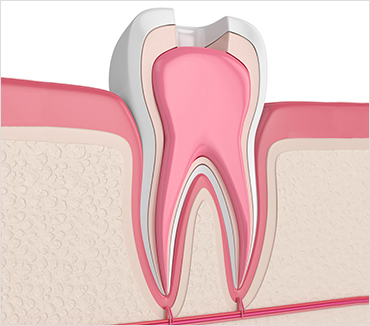Understanding Root Canal: Procedure, Causes, Treatment
Introduction
Hearing the word ‘root canal’ may give you the chills, but it’s not as scary as you think once you know all the facts. Root canal treatment is extremely beneficial for helping individuals in need of maintaining their natural smile.

Some individuals may postpone having root canal procedures out of fear from common misconceptions that they cause pain and/or illness. Not only is this a myth, but by postponing treatment there is a higher risk of experiencing these symptoms and not being able to save your natural tooth. This article will provide information for people who are looking for causes, procedures, and treatments.
What is a Root Canal?
A root canal procedure is a type of endodontic treatment, which has the purpose of eliminating disease from inside the tooth. Teeth consist of an outer layer of teeth, known as dental enamel, an inner layer known as dentin, and the innermost layer called the pulp that extends from the crown of the tooth to the roots. A root canal removes bacteria from infected pulp and seals it to help prevent reinfection.
Symptoms of an infected or damaged root canal
- Tooth sensitivity to hot or cold that lingers even once the stimulus is removed.
- Consistent pain and tenderness when chewing or applying pressure to the tooth.
- Pimples on the gums or pus discharge that is discolored.
- Swelling, inflammation, and tenderness in the oral cavity, jawline, or neck region.
- Discoloration of the gums or teeth.
- Foul taste or smell in the mouth.
Are root canals safe for the long term?
Trying to stop infection and save teeth? Root canals are both safe and effective in doing so, with long-term success rates of up to 98%.
Causes of Root Canal Infection
Tooth decay and cavities
- Poor dental hygiene can result in tooth decay, cavities, and a host of additional health problems.
- Tooth decay and cavities form due to harmful oral bacterial, which if left untreated can lead to root canal infection.
- Brushing your teeth twice a day, daily flossing, visiting the dentist regularly, and completing regular treatments recommended by your dental professional is necessary to keep your mouth healthy and disrupt bacteria from causing infections.
Trauma to the tooth
- Trauma to teeth, such as an accident that applied pressure to a tooth, can cause an infection within the dental pulp.
- A traumatic incident to teeth may result in a tooth becoming discolored.
- If you notice your tooth starting to change to a gray-black appearance, it is important to contact your dentist.
Multiple dental procedures
- Extensive dental work such as deep dental fillings or multiple restorations on the same tooth can increase the risk of needing a root canal due to the proximity to the dental pulp.
Cracks or fractures in the tooth
- Cracked or fractured teeth can allow bacteria to travel throughout the injured tooth and cause infection.
- Cracks or fractures in the tooth require dental intervention to prevent the inflammation or infection from spreading and further damaging the tooth.
Gum disease
- Gum disease is an inflammatory process caused by bacteria that attack the gums, supporting oral tissues, and teeth, including the dental pulp.
- Periodontal disease is a severe form of gum disease that can spread throughout the oral cavity and even systemically throughout the body.
Root Canal Treatment & Procedure
Prepare for Root Canal Treatment
Your dental professional will determine if you are a candidate for root canal treatment following a thorough examination and X-rays. They will be more than happy to answer any questions or concerns you have regarding treatment. Prior to the procedure, your dentist will numb the area around your tooth so that you are comfortable.
How long does the procedure take?
A root canal can take approximately 1 to 2 office visits to complete.
What to expect during the root canal process?
- During the procedure, your dentist will create an opening in the top of your tooth to allow access for the removal of the infected tissue.
- They will then add medicine within the tooth and fill the root canals with a material to help seal the tooth off from bacteria.
- A temporary filling will be inserted to cover the tooth’s opening until a permanent restoration is placed.
Follow-up care after the procedure
Once the root canal treatment is complete, you may experience sensitivity around the area for a couple of days. Be sure to follow all instructions given to you by your dentist regarding post-operative care and make any follow-up appointments recommended. If you are experiencing pain or discomfort that does not seem to go away after a couple of days, persistent swelling, or pus discharge it is important to inform your dentist immediately.
Advantages of Root Canal Treatment
- Helps preserve your natural tooth.
- Stops the spread of infection within the tooth and to other areas of the mouth such as the jawbone and soft tissues.
- Eliminates symptoms of infection making chewing more comfortable and enhancing your overall health.
- Safe, efficient, and cost-effective procedure.
Alternatives to Root Canal Treatment
In some cases, your dental professional may recommend an alternative option to root canal treatment if the tooth cannot be saved. In this case, tooth extraction is the only alternative. If a tooth must be extracted, our dental professionals offer services to replace missing teeth including dental implants, dental bridges, and partial dentures.
Conclusion and Takeaways
- Recap of the key points discussed in the blog
- Importance of addressing root canal issues promptly
Overall, a root canal is nothing to fear. Root canal treatment is a safe and effective option for saving a tooth and can alleviate you from the symptoms of an infection. It is important to address any oral issues early before progressing into further issues. One of the best ways to prevent needing a root canal is to practice good oral hygiene.




